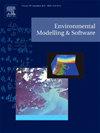Uncertainty quantification of wind gust predictions in the northeast United States: An evidential neural network and explainable artificial intelligence approach
IF 4.6
2区 环境科学与生态学
Q1 COMPUTER SCIENCE, INTERDISCIPLINARY APPLICATIONS
引用次数: 0
Abstract
Machine learning algorithms have shown promise in reducing bias in wind gust predictions, while still underpredicting high gusts. Uncertainty quantification (UQ) supports this issue by identifying when predictions are reliable or need cautious interpretation. Using data from 61 extratropical storms in the Northeastern USA, we introduce evidential neural network (ENN) as a novel approach for UQ in gust predictions, leveraging atmospheric variables from the Weather Research and Forecasting (WRF) model. Explainable AI techniques suggested that key predictive features contributed to higher uncertainty, which correlated strongly with storm intensity and spatial gust gradients. Compared to WRF, ENN demonstrated a 47 % reduction in RMSE and allowed the construction of gust prediction intervals without an ensemble, successfully capturing at least 95 % of observed gusts at 179 out of 266 stations. From an operational perspective, providing gust forecasts with quantified uncertainty enhances stakeholders’ confidence in risk assessment and response planning for extreme gust events.

美国东北部阵风预测的不确定性量化:证据神经网络和可解释的人工智能方法
机器学习算法在减少阵风预测的偏差方面显示出了希望,但仍然低估了阵风。不确定性量化(UQ)通过确定预测何时可靠或需要谨慎解释来支持这一问题。利用美国东北部61场温带风暴的数据,我们利用天气研究与预报(WRF)模式中的大气变量,将证据神经网络(ENN)作为UQ阵风预测的一种新方法。可解释的人工智能技术表明,关键的预测特征导致了更高的不确定性,这与风暴强度和空间阵风梯度密切相关。与WRF相比,新奥网络的RMSE降低了47%,并且可以在没有集合的情况下构建阵风预测区间,在266个站点中的179个站点成功捕获了至少95%的观测阵风。从业务角度来看,提供具有量化不确定性的阵风预报可以增强利益相关者对极端阵风事件风险评估和响应计划的信心。
本文章由计算机程序翻译,如有差异,请以英文原文为准。
求助全文
约1分钟内获得全文
求助全文
来源期刊

Environmental Modelling & Software
工程技术-工程:环境
CiteScore
9.30
自引率
8.20%
发文量
241
审稿时长
60 days
期刊介绍:
Environmental Modelling & Software publishes contributions, in the form of research articles, reviews and short communications, on recent advances in environmental modelling and/or software. The aim is to improve our capacity to represent, understand, predict or manage the behaviour of environmental systems at all practical scales, and to communicate those improvements to a wide scientific and professional audience.
 求助内容:
求助内容: 应助结果提醒方式:
应助结果提醒方式:


